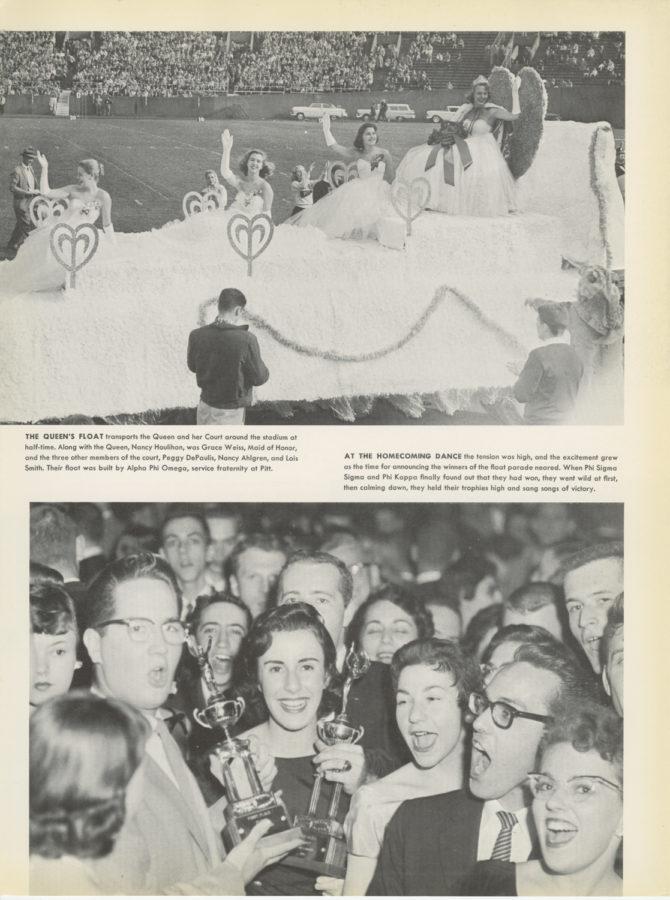Pitt’s homecoming festivities past and present
Photo courtesy of University Archives, University Library System
(Top) Pitt’s 1957 homecoming queen rides atop a float built by Alpha Phi Omega, a service fraternity at Pitt. (Bottom) Phi Sigma Sigma and Phi Kappa find out they’ve won the float parade contest.
October 4, 2018
Pitt Homecoming didn’t look very much like it does today when it first began in 1928. The earliest homecomings were nothing more than students hanging out in fraternity houses, smoking cigarettes during their “Open House Smokers.” Since then, floats, parades and dances have been added to the homecoming festivities — all leading up to the annual homecoming football game.
Pitt’s first homecoming took place the weekend of Nov. 9-10 in 1928. According to Sports Reference, Pitt won its first homecoming football game against Washington and Jefferson 25-0.
While researching the history of homecoming across the country, Pitt University Library System archivists Zachary Brodt and Kathleen Donahoe found that the first-ever homecoming took place at the University of Missouri in 1911. Chester Brewer, the university’s football coach and athletic director, commented on the event to The Missouri Student back in the 1930s.
“As I remember,” Brewer said, “Missouri was the first school to sponsor the idea of an annual reunion on the day of some important football game, and Missouri unconsciously developed the idea way back in 1911.”
Brewer came up with the idea of homecoming in 1910 after the Missouri Valley Intercollegiate Athletic Association said college campuses must host conference games — meaning the game would move from its original location in Kansas City, Mo., to the University of Missouri’s campus.
With the game moving to the much less populous Lebanon, Brewer decided to encourage alumni to come back to the university as a strategy to keep attendance and revenue high for the annual game — and so the first homecoming was born.
According to Brodt and Donahoe, the idea rapidly caught on at other universities. It isn’t clear why Pitt didn’t host its first homecoming until 18 years after Missouri, but lack of finances may have been what held the administration back. The Cathedral of Learning was under construction during this time, which Donahoe said may have caused Pitt to fall behind the homecoming trend.
From the 1920s to the 1960s, homecoming was a year-round event that included smokers’ parties and formal dances. The first Pitt homecoming in 1928 wasn’t widely celebrated, but when Pitt played Ohio State University in 1929, the popularity of the celebration soared.
Pitt’s homecoming took a hiatus during the 1940s following the advent of World War II. Upon its return in the 1950s, the University began a homecoming court and started the tradition of parades with floats made by Pitt sororities and fraternities.
“The ‘50s seems to be this period where things kind of start to evolve from the initial kind of fraternity-driven activities to university-wide [ones],” Brodt said.
Pitt didn’t have a consistent set of homecoming traditions during early celebrations. Sometimes, Pitt would invite the opposing team of the homecoming game to a big celebration — like the game against Ohio State University in 1929, when Pitt found OSU alumni living around Pitt and invited them to the festivities, including smoking parties.
“In the early traditions, they would actually invite Ohio State alumni to come to the smoker and they would have the Ohio State coach there to make a speech,” Donahoe said. “It was more of a community thing rather than a Pitt thing.”
An article in The Pitt News from October 1955 noted the tradition of including live animals in parades — even real versions of the school’s mascot.
“In 1933, Pitt was given a live panther cub to fight Navy’s goat,” the article said. “At another homecoming celebration ‘Jock’ Sutherland was presented with a baby lamb with blue and gold ribbons tied around its neck. In 1947 alumni released 1,000 homing pigeons on the field preceding the tilt.”
Concerts, fireworks and keg-rolling competitions sponsored by different alcohol companies each year became a part of the annual celebration in the 1970s. Chancellor Wesley Posvar, who held the position from 1967 to 1991, participated in the keg-rolling competition as well.
A substantial difference between the 1930s and today’s homecoming celebrations, Donahoe said, is the lack of a community celebration. In the 1930s, homecoming was all about uniting the University — but since the 1990s, schools within Pitt have focused more on individualized celebrations.
“You don’t necessarily have the big ‘come together as a university’ thing anymore, which is what in 1928 it kind of started as,” Donahoe said.
Jana Sestili, the current Alumni Association assistant executive director, helps coordinate the homecoming events with the Alumni Association. She graduated in 1992 with a degree in communication and loved homecoming during her time as a student.
“My favorite part was the fireworks and laser show produced by the Pitt Program Council, and of course, the football game,” Sestili said.
With the changing of traditions in Pitt’s homecoming history, Sestili gave insight into how they choose events now — by researching alumni interests.
“[The research] creates what we call ‘homecoming signature’ events and programs — programs we feel will put a finger on the pulse of all alumni without regard from their degree or school they graduated from or for their particular affinity,” Sestili said.
Sestili said homecoming is important because it connects current students to past ones.
“Homecoming is a timeless tradition that brings everyone together and celebrates all the traditions of Pitt and nothing else compares to it,” Sestili said. “It is uniquely ours and why we ‘Hail to Pitt!’”








